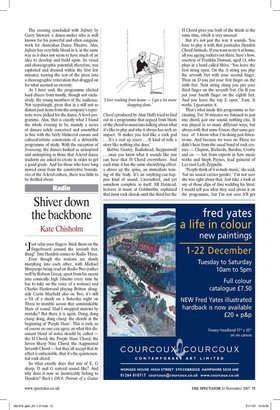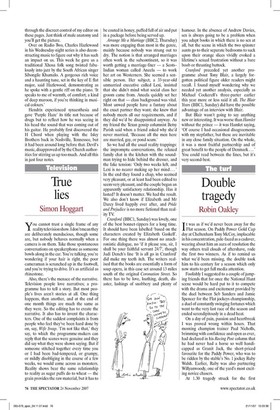Shiver down the backbone
Kate Chisholm Tust relax your fingers. Stick them on the J fingerboard around the seventh fret. Bang!' Jimi Hendrix comes to Radio Three.
Even though the stations are slowly morphing into each other, with Michael Morpurgo being read on Radio Two (rather well by Robson Green, apart from his ascent into comically high falsetto every time he has to take on the voice of a woman) and Charles Hazlewood playing Britten alongside Curtis Mayfield also on Two, it's still a bit of a shock on a Saturday night on Three to stumble across that unmistakable blaze of sound. Had I swapped stations by mistake? But there it is again. Dong, dong chang dong, dong chang: the chords at the beginning of 'Purple Haze'. This is rock, so of course no one can agree on what this dissonant blend of notes should be called — the H Chord, the Purple Haze Chord, the Seven Sharp Nine Chord, the Augmented Seventh Chord — but they all accept that its effect is unbeatable, that it's the quintessential rock chord.
So what exactly does that mix of E, G sharp, D and G natural sound like? And why does it now so inextricably belong to Hendrix? Rock's DNA: Portrait of a Guitar Chord (produced by Alan Hall) tried to find out in a programme that segued from blasts of the chord to musicians talking about what it's like to play and why it always has such an impact. 'It makes you feel like a rock god ... It's a real up yours ... It kind of tells a story like nothing else does.'
Bobbie Gentry, Radiohead, Steppenwolf ... once you know what it sounds like you can hear that H Chord everywhere. And each time it has the same electrifying effect: a shiver up the spine, an immediate tensing of the body. It's an anything-can-happen kind of sound. Unresolved, and yet somehow complete in itself. Jill Halstead, lecturer in music at Goldsmiths, explained that most rock chords omit the third but the H Chord gives you both of the thirds at the same time, which is very unusual.
But it's not just the way it sounds. You have to play it with that particular Hendrix Chord Attitude. If you want to try it at home, all you ageing rockers out there, here's how, courtesy of Franklin Dawson, aged 14, who plays in a band called Shiva. 'You leave the first string open. On the A string you play the seventh fret with your second finger. Then on D you put your first finger on the sixth fret. Next string along you put your third finger on the seventh fret. On B you put your fourth finger on the eighth fret. And you leave the top E open.' Easy. It works. I guarantee it.
That's what made this programme so fascinating. For 30 minutes we listened to just one chord, just one sound, nothing else. It was played in so many different ways, but always with that same frisson, that same gesture of I-know-what-I'm-doing-just-listento-me. And because we were on Three we didn't hear from the usual band of rock cronies — Clapton, Richards, Burdon, Crosby and co. — but from experts in how music works and Steph Paynes, lead guitarist of Lez (not Led) Zeppelin.
'People think of it as male music,' she said, 'but no sound carries gender.' I'm not sure she was right about that. Just take a look at any of those clips of Jimi wielding his Strat.
I would tell you what they said about it on the programme, but I'm not sure it'll get through the discreet control of my editor on these pages. Just think of male anatomy and you'll get the picture.
Over on Radio Two, Charles Hazlewood in his Wednesday-night series is also deconstructing music to figure out why it has such an impact on us. This week he gave us a traditional Xhosa folk song twisted fabulously into jazz by the South African singer Sibongile Khumalo. A gorgeous rich voice and a haunting tune, set in the key of E flat major, said Hazlewood, demonstrating as he spoke with a gentle riff on the piano. 'It speaks to me of warmth, of comfort; a kind of deep maroon, if you're thinking in musical colours.'
Hendrix experienced synaesthesia and gave 'Purple Haze' its title not because of drugs but to reflect how he was seeing in his head the sound that was coming out of his guitar. He probably first discovered the H Chord when playing with the Isley Brothers back in Nashville, Tennessee, but it had been around long before that. Devil's music, disapproved of by the Church authorities for stirring us up too much. And all this in just four notes.







































































 Previous page
Previous page